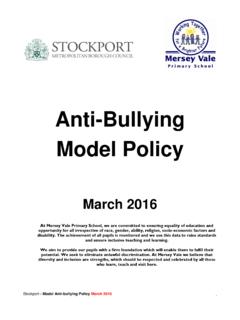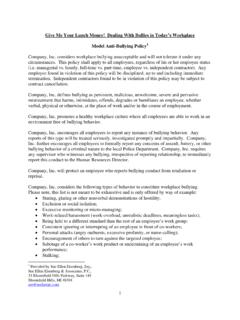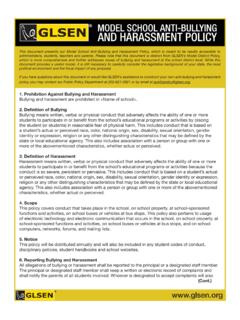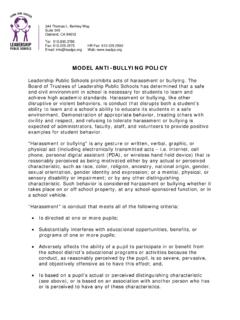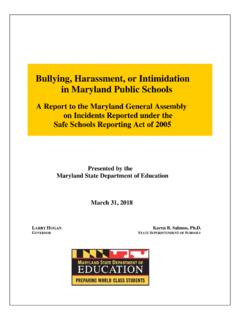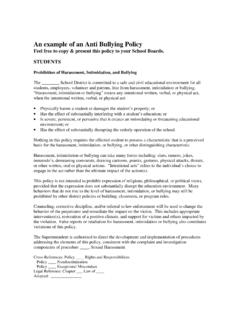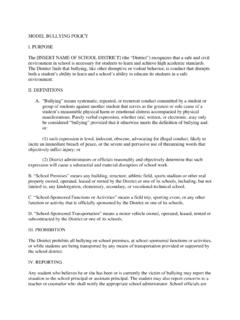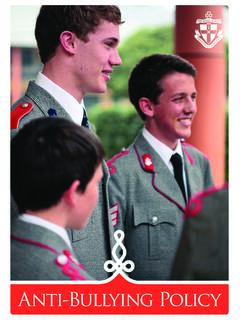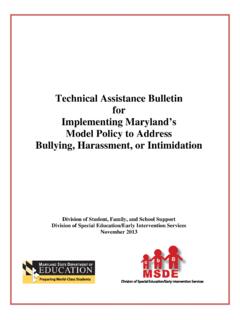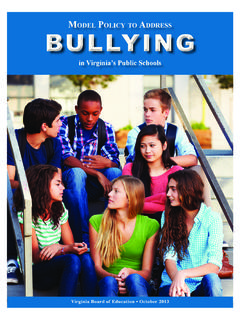Transcription of Anti-Bullying Policy (Based on the Stockport MBC Model ...
1 Anti-Bullying Policy Mersey Vale Primary School March 2017 1 Anti-Bullying Policy (Based on the Stockport MBC Model Anti-Bullying Policy February 2017) At Mersey Vale Primary School, we are committed to ensuring equality of education and opportunity for all irrespective of race, gender, ability, religion, socio-economic factors and disability. The achievement of all pupils is monitored and we use this data to raise standards and ensure inclusive teaching and learning. We aim to provide our pupils with a firm foundation which will enable them to fulfil their potential. We seek to eliminate unlawful discrimination.
2 At Mersey Vale we believe that diversity and inclusion are strengths, which should be respected and celebrated by all those who learn, teach and visit here. Aim: At Mersey Vale Primary School we are committed to working with children, staff, governors and parents/carers to create a school community where bullying is not tolerated. Our school is a place where every person has the right to be themselves, to be included and to learn in a safe and happy environment. Everyone at our school is equal and is expected to treat each another with respect and kindness. bullying of any kind is unacceptable and will not be tolerated at our school. At our school the safety, welfare and well-being of all pupils and staff is a key priority.
3 We take all incidences of bullying seriously and it is our duty as a whole school community to take measures to prevent and tackle any bullying , harassment or discrimination. We actively promote values of respect and equality and work to ensure that difference and diversity is celebrated across the whole school community. We want to enable our pupils to become responsible citizens and to prepare them for life in 21st Century Britain. These values reflect those that will be expected of our pupils by society, when they enter secondary school and beyond in the world of work or further study. We are committed to improving our school s approach to tackling bullying and regularly monitor, review and assess the impact of our preventative measures.
4 We define bullying as: Behaviour by an individual or a group, usually repeated over time, where an imbalance of power is used to intentionally hurt another either physically or emotionally. Anti-Bullying Policy Mersey Vale Primary School March 2017 2 Developing a whole school approach: At Mersey Vale Primary School we work closely with members of the schools community to ensure the involvement and participation of students, parents, staff, governors and the wider community as part of the development of Policy related to supporting a positive ethos within the school. We believe that: All bullying is unacceptable irrespective of how it happens and/ or what excuses are given in an attempt to justify it.
5 We must investigate all incidents of bullying and take action where necessary, supporting both the bully and the victim at all times. We must take all incidents of bullying seriously and consider the needs of those affected. Children who bully must be held to account for their wrongdoing, but may need support to change their attitudes and behaviour. Accountability will be sought in all incidents of bullying , seeking identification of wrongdoing and supporting repairing of harm done through a solution based approach. All inappropriate language that perpetuates attitudes underpinning bullying behaviour must be challenged at all times. Everyone in our school has a responsibility to respond promptly and effectively to all instances of bullying .
6 We must communicate with parents/ carers regarding any concerns about bullying and deal promptly with complaints. All our children must feel safe and be confident that any reported incidents will be dealt with effectively by all responsible adults. It is important to focus upon preventing bullying behaviours in school. Identifying and supporting vulnerable children We work closely in school to identify particularly vulnerable groups, perhaps minority ethnic groups, travellers, refugees, LGBT pupils, midterm arrivals, pupils who transfer late into the school, children or young people in care, young carers, teenage parents and those with other special needs who may find it more difficult to make or sustain friendships.
7 As a school we plan positive action to support these pupils with all relevant staff members and provide additional support where necessary, for example peer support through buddy schemes and helping them access clubs and out of school provision. Who is bullied? Anybody could be subject to bullying at any time in their life. It is not only something that affects children and young people. A person is bullied when, either as an individual or part of a group, she or he suffers in any way from the direct result of intentional and persistent harassment and/ or victimisation by another individual or group. Anti-Bullying Policy Mersey Vale Primary School March 2017 3 A person who has been bullied may commonly find it difficult to combat victim behaviour or report their experiences to those who may be able to help them.
8 Below are some factors that can make people vulnerable: Children and young people who are at most increased risk of being the victims or perpetrators of bullying are those who: are in foster care or residential homes (looked after children) have specific special educational needs (especially on the autistic spectrum) have a disability or impairment are from minority ethnic backgrounds are refugees or asylum seekers start a school or activity group mid term are, or are perceived to be, gay, lesbian, bisexual, transgender or questioning of their sexuality or gender speak a first language other than English are young carers have suffered bereavement have suffered domestic violence have experienced physical or emotional trauma have a parent that was a victim of bullying Anti-Bullying Policy Mersey Vale Primary School March 2017 4 Methods of bullying .
9 There are a number of methods of bullying which can be summarised as: Physical aggression hitting, kicking, tripping up, spitting, taking or damaging property, use of threat or force in any way, intimidation or demands for money or goods Verbal name calling, insulting, teasing, jokes , mocking, taunting, gossiping, secrets, threats. Reference to upsetting events bereavement, divorce, being in care Non-verbal staring, body language, gestures Indirect excluding, ostracising, rumours and stories, emails, chat rooms, messaging phones, notes, inappropriate gestures Cyber text messaging, internet chat rooms, the use of social media applications such as Snapchat, Instagram or WhatsApp, burn pages (on Facebook), , the misuse of camera or video facilities (including self-generated inappropriate images), offensive questions (on )
10 , nasty inbox messages We acknowledge that some acts of bullying will constitute a criminal offence and in these cases other organisations will need to be contacted the Police or Social Care Types of bullying There a various types of bullying which can be summarised as: Racist and faith based name calling, derogatory assumptions or generalisations about race, culture, religious faiths and beliefs Sexual orientation homophobic, transphobic or biphobic based on actual or perceived sexual orientation, and can include name calling, exclusion and gestures, negative stereotyping based on sexual orientation, using gay as a negative term, warning others about a person, graffiti, etc.
